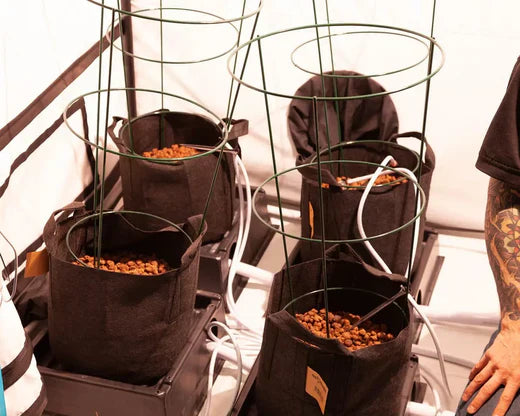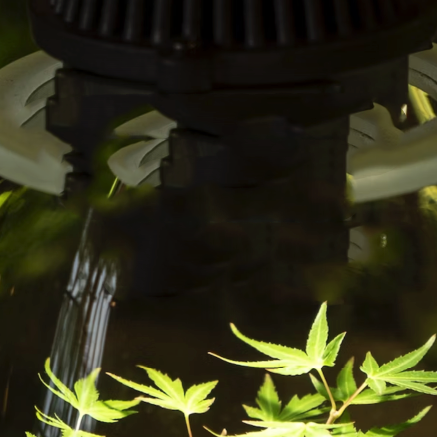Cloth Pots - The Whys and the Hows!
About 20 years ago, Superoots released the revolutionary Air-Pot on to the plant pot market. At that time, uptake was slow and was mostly confined to the plant nursery and other parts of the commercial sector. However, as time went by, word eventually leaked out about the wonders of "root-pruning" pots and their popularity has steadily increased ever since.
The Wonders of Root-Pruning
Roots are sometimes called the engine of a plant. They are the unseen heroes of fruit and flower production. Nothing can be produced by the plant if it cannot access water and nutrients.
The root-mass provides everything (except Carbon Dioxide) that the plant needs. Without an adequate root-mass, the plant will never be able to reach its full potential in terms of quality or yield.
With a standard plant pot, the root-shoot hits the side-wall. It then stops growing briefly and then navigates its way around the "obstruction" by turning slightly and then circling around and around tightly against the inside of the pot side-wall.
This is an incredibly inefficient use of the space and the medium inside the pot. Only the outer centimetre or so becomes densely inhabited by roots. The bulk of the grow-medium remains more or less devoid of roots. What a waste of space - literally!
It's all about the Roots!
In an air-pruning pot, the growth pattern of the roots is very different. The roots grow out from the bottom of the plant as before, but when they hit the side of the pot, they encounter much drier air. The root cannot continue to grow in this drier environment so further root elongation, which would lead to root-circling, cannot occur.
In order to be able to continue to grow, the plant needs to find a new strategy to increase the size of its root-mass. The tip of the obstructed root-shoot produces a chemical messenger called ethylene (which is one of the 6 main types of plant hormone). The presence of ethylene signals to the rest of the root-shoot (and also the rest of the plant) that it can grow no further and this has 2 main effects:
- The root-shoot responds to the increase in ethylene by making the most of the root-shoot that has already grown. It does this by thickening and greatly increasing the production of side-shoots and root-hairs coming from it.
- The rest of the plant responds to the increase of ethylene by sending out new root-shoots in different directions from its base.
The concept of root-pruning is fascinating. A pot that can stop root-shoots from continuously elongating means that the plant will send out more and more main root-shoots, swell the existing ones, and encourage the production of root-hairs means that the whole of the medium inside of the pot becomes filled with roots.
Double the Roots in the Same Size Pot!
Can you imagine being able to reduce pot size by half, yet still be able to produce the same yields of a similar quality? The savings in grow-medium and space are huge. Root-pruning pots offer all this and more. A fantastic opportunity!
Superoots Air-Pots were pretty much the first plant-pots that allowed gardeners to harness the power of root-pruning. Since then the concept has been copied in various different ways. Less expensive versions have been produced and, most recently, an incredibly economical solution has been introduced in the form of fabric pots.
Air Pruner Fabric Pots - Highly Economical Root Pruning
Fabric pots work slightly differently but produce the same effect. When the tip of a root-shoot gets to within the vicinity of the wall of a fabric pot, the moisture level goes down considerably. As with Superoots Air-Pots, the root-shoot cannot continue to grow and circle around the side-wall of the pot because it is too dry.
As a result, the process of ethylene production begins and the plant's root-growth follows the process described above. The root-shoot thickens, the plant sends out more side-roots, and the roots themselves produce more and more side-shoots.
The Versatility of Fabric Pots
Fabric pots don't just have to be used in a hand-watering system. They can be used to very great effect in a dripper system. We have many customers who have replaced the square plastic pots in their Wilma Dripper System with fabric pots and they achieve greater yields as a result. Alternatively, there is the Easy-Feed bottom feed system that is becoming ever more popular. Nutrient solution is run from a reservoir to a tray or trays that contain fill-valves. When the bottom of the tray becomes dry, the valve allows some nutrient solution into the tray. The medium inside the fabric pot then wicks it upwards, watering and feeding the plant as it does so.
A quality fabric pot can be used over and over many times if just a little care is taken with it. Transporting fabric pots could hardly be easier - they're incredibly light and they fold flat requiring very little space. For the same reasons, they're incredibly easy to store when they're not in use too!

